The team lead or a designee needs to make input documents available to the participants prior to the meeting-normally within days of the end of the measurement period and within a week of the scheduled Operations Review. It is expected that each participant will review the Operations Review input documents, mentioned in the following section, prior to the meeting and will have managed any exceptional or abnormal results.
The Operations Review management forum might be required to ratify specific management intervention and action, but it is not the appropriate meeting to discuss any unexpected results at any great length. If necessary, participants should arrange analysis meetings prior to the Operations Review. In these meetings, all involved parties are assembled in one forum to address unexpected events and to jointly decide on the service improvement plan (SIP) to be discussed at the Operations Review.
Team Lead Confirms Inputs
As with any operations management review (OMR) meeting, there are several inputs to the Operations Review, some of which are essential to the review procedure; others may be optional but useful under certain circumstances. The varied types of metrics that can be included as inputs are intended to give a more holistic or balanced view of the operations organization.
There are likely to be typical deliverables from the Operations Review and deliverables dependent on the contents and actions in the review.
Required Inputs
The following inputs are required.
OLA Document
The operating level agreement (OLA) document should be brought to the Operations Review as a reference for any discussion of performance against OLA objectives. In addition, the OLA document should be referenced in case of changes to the OLA or the objectives, priorities, costs, and contacts. For assistance in documenting and formalizing the agreement, see the Microsoft Operations Framework (MOF) Service Level Management Service Management Function guide, available at the Microsoft Operations Framework (MOF).
Template versions of these documents are available online at Operations Templates.
The OLA will contain those metrics that define the IT quality parameters for the service solution that is being delivered. These may differ slightly from the SLA measurements that are business-related and will often have been formulated using a combination of OLA measurements. For example, in many instances there are no tools implemented to measure end-to-end availability of a service, or as the Information Technology Infrastructure Library (ITIL) terms it, "Total Infrastructure Availability." Service level management (SLM) can use the configuration database to identify all the serial components that are used to provide that service, and the availability of each of those can be included to determine a final availability percentage. Further information on different methods to calculate availability is contained in the ITIL Service Delivery book: Service Delivery (ISBN: 0113300174), 2001. This ITIL publication, published in print and CD-ROM formats, is available from the The Stationery Office.
OLA Performance Reports
The OLA performance reports, showing performance against the OLA, should be available at the Operations Review. If this is a virtual meeting, the operations manager or a designee should provide the reports by e-mail or post them to a shared folder or intranet for discussion. The reports should be distributed in advance of the review in order to give an opportunity to consider the metrics and to form thoughts on the performance against targets for the service. Participants should prepare questions and feedback as appropriate. It is recommended that a root-cause analysis report be included in the distributed pack for all major service disruptions or service levels not achieved.
It is recommended that each team produce a snapshot of its performance in a single slide to give a quick but effective visual idea of the team's individual business. The slide should simply contain the team's highlights, lowlights, and key performance indicators (KPIs) for the month.
 Note: Note: |
|---|
| The Microsoft Office Business Scorecards Accelerator is a new business intelligence offering that enables employees to define, visualize, and manage scorecard metrics and strategies across the enterprise. The Business Scorecards Accelerator is a Web-based solution that allows people to define and manage scorecard metrics efficiently using familiar applications, and it delivers the tools needed to communicate the relationships between KPIs and concrete business objectives. Further information about the Microsoft Office Business Scorecards Accelerator is available at Microsoft Office PerformancePoint Server 2007. Further information about Microsoft Business Intelligence is available at Microsoft Business Intelligence. |
Operational Guides and Service-Solution Specifications
All operational documentation should be contained in the corporate knowledge base. This information should be readily available during the review in case it must be quickly inspected due to issues such as lack of performance. It may be necessary to change specific operational procedures or configuration attributes to improve delivery performance for the next measurement period.
 Note: Note: |
|---|
|
Actions and Minutes from the Previous Operations Review
Key decisions will be made and specific actions assigned to ensure continuous performance improvement. It is essential that the minutes from the previous meeting be available. Also, action owners must be present; otherwise, a suitable representative must be sent to provide updates as necessary.
For online examples of templates containing OMR action items and minutes, see Operations Templates. These templates can be adapted and used as pertinent to the Operations Review.
Optional Inputs
The following inputs are optional.
Operations Risk Register
MOF advocates the use of a risk register to continuously assess and monitor the possible risk exposure associated with delivering IT services. The risk register will likely contain risks that are directly related to the performance of the IT operations services. These must be reviewed regularly and at a senior management level. It is thus strongly recommended that the Operations Review include a specific item on the agenda to review the risk register.
Customer Satisfaction Surveys
It is not enough for operations to review service performance at a technical level only; IT must use service level management to provide the customers' perception of the services being delivered. The service delivery manager should rate the performance of the various service delivery teams within operations so that those ratings can be compared with actual performance achieved during the Operations Review. There might very well be a difference between the two, indicating a problem that needs to be addressed urgently with service level management. Changes might be necessary to the SLA and associated OLA performance measurements. Or the service solution itself may have to be redefined since it is not really delivering what the business requires, even though it may be operating at acceptable performance levels.
Each set of metrics needs to be defined together with Red/Amber/Green (RAG) qualification parameters to help clearly illustrate the state of each component within the review. The following graphic illustrates a sample customer satisfaction RAG chart.
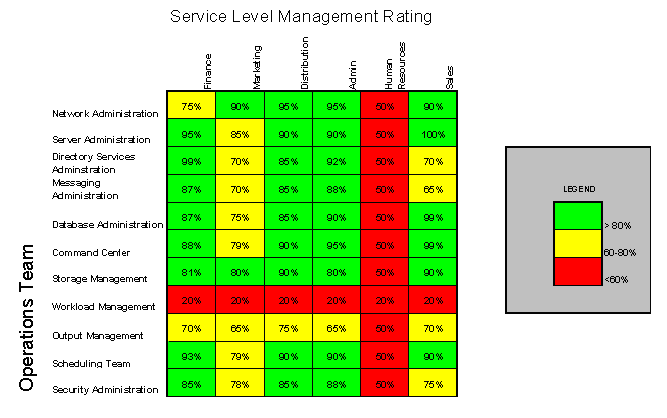
Financial Management Metrics
IT operations is a business in itself and will have a prescribed budget with which to deliver the required technology services. Thus it is essential that the management of each unit within operations manage its costs accordingly. MOF dedicates an entire service management function (SMF) to the discipline of financial management. The Financial Management SMF assists IT management in effectively performing budgeting, accounting, and charging functions. Although operations management does not own the financial management processes, it does have a corporate responsibility to integrate with those processes in order to manage its individual businesses. Further information is contained in the Financial Management SMF, available at the Microsoft Operations Framework (MOF).
The following graphic illustrates a sample financial control RAG chart.
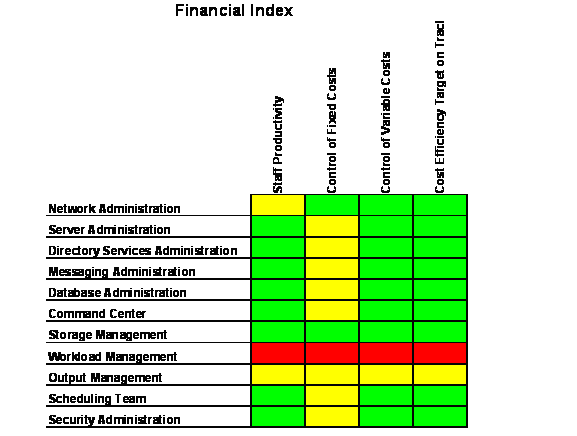
 Note: Note: |
|---|
| Operations line management will need to engage Finance Management to determine what metrics should be used to manage their own internal costs. The metrics in the sample chart are for display purposes only. Each set of metrics needs to be defined together with Red/Amber/Green (RAG) qualification parameters, so that the Operations Review participants can readily view the finance performance of the respective team. |
One of the highest costs in the IT organization is the budget for staff. It is recommended that the utilization and performance of the staff be regularly reviewed and that any anomalies be compared against the actual service being delivered. For example, suppose the server administration team is achieving the required performance levels, but that utilization levels are over 100 percent. This effectively means that the staff members are regularly working overtime, which is not a sustainable situation. Alternatively, service levels may be achieved, but with very low levels of utilization. This might indicate that the team is overstaffed and that further efficiencies can be realized.
People Health Metrics
IT services are delivered by people using a combination of personal skills and experience together with documented operational procedures. Although the Operations Review is not meant to become a human resources (HR) meeting, it is a recommended practice that senior management use a set of basic HR metrics to indicate variance against norms and possible trends that might expose the future delivery of quality operations.
These measurements should include morale indexes, skills and development indexes, and finally attrition indexes, since every person who leaves the organization takes a significant amount of knowledge with him or her, irrespective of how well documented the operation is. Operations management is then given an opportunity to manage these variances before they crucially affect the delivery of IT service performance levels.
The following graphic illustrates a sample employee health RAG chart.
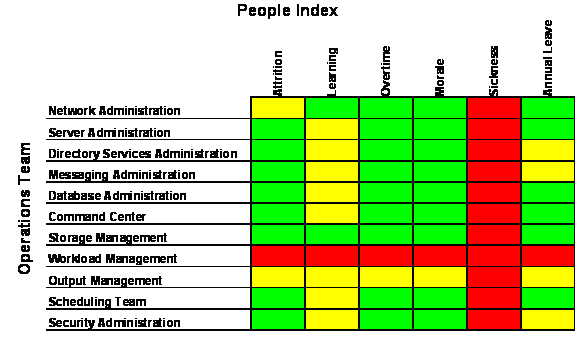
 Note: Note: |
|---|
| Operations line management will need to engage Human Resources to decide on a set of metrics and parameters to measure the employee health index. The metrics shown in this sample chart are for display purposes only and should not be assumed to be a complete or accurate list of metrics to be used in this scorecard. |
Operations Process Maturity Metrics
As with any other business process, operations must strive to continuously improve its effectiveness and efficiency in supporting the overall goals of the business by deploying and implementing improvement processes. Microsoft Services has developed a MOF process-maturity review for all the MOF quadrants that can greatly assist in this endeavor. Although the Operations Review is primarily involved with the SMFs in the Operating Quadrant, it has dependencies on the successful implementation of processes in the remaining three quadrants-Changing, Supporting, and Optimizing.
It is recommended that the process maturity specific to the Operating Quadrant SMFs be reviewed regularly by senior management in the Operations Review and that the progress of improvement actions be monitored in the same forum.
The following graphic illustrates a sample process-maturity scorecard.
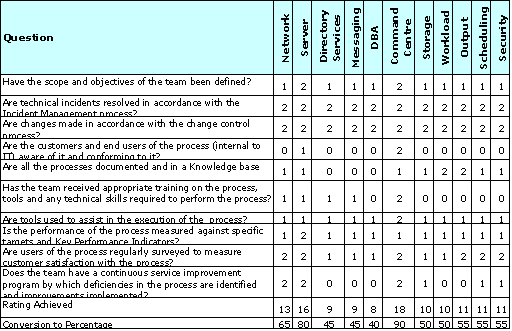
The following graphic illustrates a sample plotting of the process-maturity scorecard data.
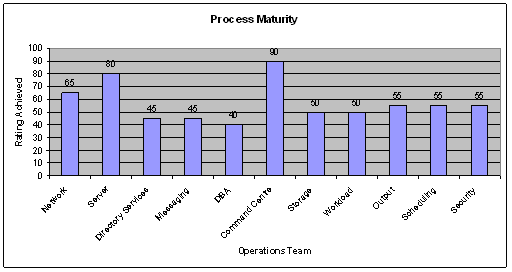
Participants Complete Pre-Work Templates
All team members take their respective pre-work template and complete it for the applicable functional area. In other words, they annotate the sheet with issues, kudos, documented data to support or refute claims being made or actions to be taken and suggested action items.